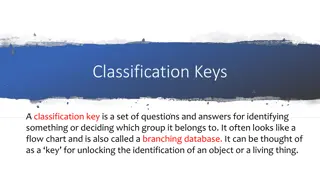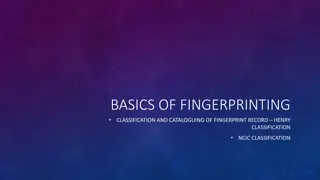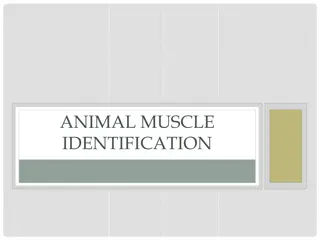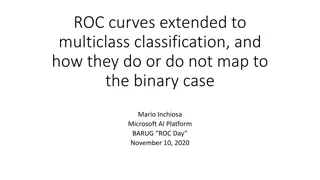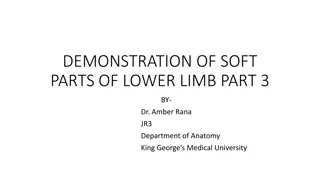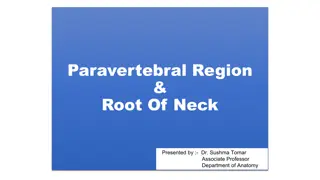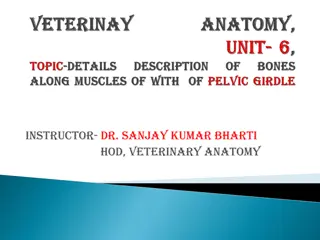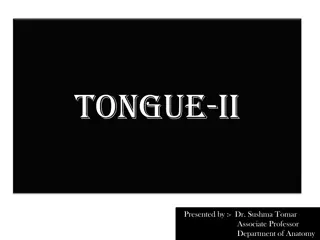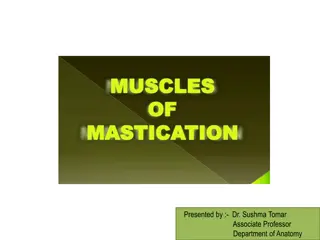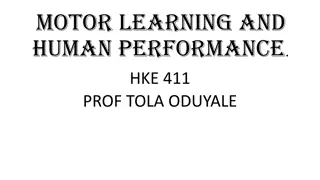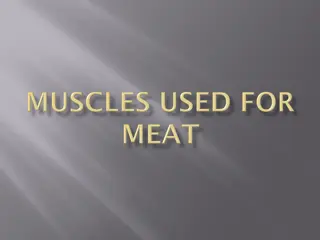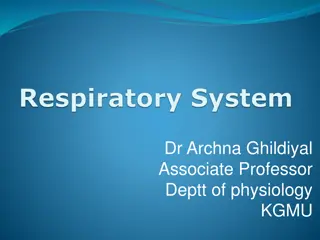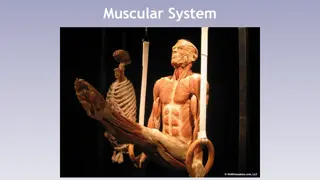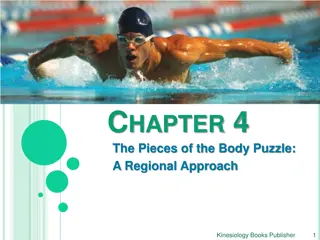Back Muscles Overview and Classification
Detailed overview of back muscles including classification into deep, intermediate, and superficial groups. Covers muscle functions, nerve supply, attachments, and clinical significance. Provides insights into distinguishing different back muscle groups and their actions.
Download Presentation

Please find below an Image/Link to download the presentation.
The content on the website is provided AS IS for your information and personal use only. It may not be sold, licensed, or shared on other websites without obtaining consent from the author.If you encounter any issues during the download, it is possible that the publisher has removed the file from their server.
You are allowed to download the files provided on this website for personal or commercial use, subject to the condition that they are used lawfully. All files are the property of their respective owners.
The content on the website is provided AS IS for your information and personal use only. It may not be sold, licensed, or shared on other websites without obtaining consent from the author.
E N D
Presentation Transcript
Half Term 1 Half Term 2 Half Term 3 Half Term 4 Half Term 5 Half Term 6 Developing communication skills To be able to identify the purpose, audience and format of a text To give short speeches and presentations, expressing their own ideas and keeping to the point To use Standard English confidently in a range of formal and informal contexts, including classroom discussion Writing for a wide range of purposes and audiences, including notes and polishes scripts for talks and presentations Plan, draft and edit and proof-read through - Considering how their writing reflects the audiences and purposes for which it was intended - Amending the vocabulary, grammar and structure of their writing to improve its coherence and overall effectiveness - Paying attention to accurate grammar, punctuation and spelling, applying the spelling patterns and rules set out in English Speaking and listening To use Standard English confidently in a range of formal and informal contexts, including classroom discussion To give short speeches and presentations, expressing their own ideas and keeping to the point To participate in formal debates and structured discussions, summarising and/or building on what has been said improvising, rehearsing and performing play scripts and poetry in order to generate language and discuss language use and meaning, using role, intonation, tone, volume, mood, silence, stillness and action to add impact Reading and writing styles Understand increasingly challenging texts through learning new vocabulary, relating it explicitly to known vocabulary and understanding it with the help of context and dictionaries Making inferences and referring to evidence in the text Knowing the purpose, audience for and context of the writing and drawing on this knowledge to support comprehension Checking their understanding to make sure that what they have read makes sense Pupils should be taught to write accurately, fluently, effectively and at length for pleasure and information through writing for a wide range of purposes and audiences, including: stories, scripts, poetry and other imaginative writing Applying their growing knowledge of vocabulary, grammar and text structure to their writing and selecting the appropriate form Drawing on knowledge of literary and rhetorical devices from their reading and listening to enhance the impact of their writing Plan, draft, edit and proof-read through considering how their writing reflects the audiences and purposes for which it was intended Reading for pleasure Understand increasingly challenging texts through learning new vocabulary, relating it explicitly to known vocabulary and understanding it with the help of context and dictionaries Making inferences and referring to evidence in the text Knowing the purpose, audience for and context of the writing and drawing on this knowledge to support comprehension Checking their understanding to make sure that what they have read makes sense Pupils should be taught to write accurately, fluently, effectively and at length for pleasure and information through writing for a wide range of purposes and audiences, including stories, scripts, poetry and other imaginative writing Applying their growing knowledge of vocabulary, grammar and text structure to their writing and selecting the appropriate form Drawing on knowledge of literary and rhetorical devices from their reading and listening to enhance the impact of their writing Plan, draft, edit and proof-read through considering how their writing reflects the audiences and purposes for which it was intended Writing for a purpose Plan, draft, edit and proof- read through considering how their writing reflects the audiences and purposes for which it was intended Amending the vocabulary, grammar and structure of their writing to improve its coherence and overall effectiveness Paying attention to accurate grammar, punctuation and spelling; applying the spelling patterns and rules set out in English Appendix 1 to the key stage 1 and 2 programmes of study for English Write accurately, fluently, effectively and at length for pleasure and information through writing for a wide range of purposes and audiences, including a range of other narrative and non- narrative texts, including arguments, and personal and formal letters Write accurately, fluently, effectively and at length for pleasure and information through writing for a wide range of purposes and audiences, including stories, scripts, poetry and other imaginative writing Reading for a purpose Understand increasingly challenging texts through learning new vocabulary, relating it explicitly to known vocabulary and understanding it with the help of context and dictionaries Making inferences and referring to evidence in the text Knowing the purpose, audience for and context of the writing and drawing on this knowledge to support comprehension checking their understanding to make sure that what they have read makes sense Write accurately, fluently, effectively and at length for pleasure and information through writing for a wide range of purposes and audiences, including stories, scripts, poetry and other imaginative writing Applying their growing knowledge of vocabulary, grammar and text structure to their writing and selecting the appropriate form Drawing on knowledge of literary and rhetorical devices from their reading and listening to enhance the impact of their writing English Short course E3 - L1
Half Term 1 Half Term 2 Half Term 3 Half Term 4 Half Term 5 Half Term 6 Developing communication skills Speaking and listening Reading and writing styles Amending the vocabulary, grammar and structure of their writing to improve its coherence and overall effectiveness, paying attention to accurate grammar, punctuation and spelling; applying the spelling patterns and rules set out in English Appendix 1 to the key stage 1 and 2 programmes of study for English Reading for pleasure Amending the vocabulary, grammar and structure of their writing to improve its coherence and overall effectiveness, paying attention to accurate grammar, punctuation and spelling; applying the spelling patterns and rules set out in English Appendix 1 to the key stage 1 and 2 programmes of study for English Writing for a purpose Reading for a purpose Plan, draft, edit and proof-read through considering how their writing reflects the audiences and purposes for which it was intended Amending the vocabulary, grammar and structure of their writing to improve its coherence and overall effectiveness Paying attention to accurate grammar, punctuation and spelling; applying the spelling patterns and rules set out in English Appendix 1 to the key stage 1 and 2 programmes of study for English English Short course E3 - L1
Probability and Statistics Record, describe and analyse the frequency of outcomes of simple probability experiments involving randomness, fairness, equally and unequally likely outcomes using appropriate language and the 0-1 probability scale understand that the probabilities of all possible outcomes sum to 1 To construct and interpret appropriate tables, charts, and diagrams, including frequency tables, bar charts, pie charts, and pictograms for categorical data, and vertical line (or bar) charts for ungrouped and grouped numerical data To describe simple mathematical relationships between two variables (bivariate data) in observational and experimental contexts and illustrate using scatter graphs. To describe, interpret and compare observed distributions of a single variable through: appropriate graphical representation involving discrete, continuous and grouped data; and appropriate measures of central tendency (mean, mode, median) and spread (range, consideration of outliers) Money Number Understand and use place value for decimals, measures and integers of any size Use the four operations, including formal written methods, applied to integers, decimals, proper and improper fractions, and mixed numbers, all both positive and negative Define percentage as number of parts per hundred , interpret percentages and percentage changes as a fraction or a decimal, interpret these multiplicatively, express one quantity as a percentage of another, compare two quantities using percentages, and work with percentages greater than 100% Interpret fractions and percentages as operators Use a calculator and other technologies to calculate results accurately and then interpret them appropriately Appreciate the infinite nature of the sets of integers, real and rational numbers Use the concepts and vocabulary of prime numbers, factors (or divisors), multiples, common factors, common multiples, highest common factor, lowest common multiple, prime factorisation, including using product notation and the unique factorisation property Geometry and Measure Draw 2-D shapes using given dimensions and angles Solve problems involving the calculation and conversion of units of measure, using decimal notation up to three decimal places where appropriate Calculate, estimate and compare volume of cubes and cuboids using standard units, including cubic centimetres (cm3) and cubic metres (m3), and extending to other units [for example, mm3 and km3] Recognise, describe and build simple 3-D shapes, including making nets Use, read, write and convert between standard units, converting measurements of length, mass, volume and time from a smaller unit of measure to a larger unit, and vice versa, using decimal notation to up to three decimal places Compare and classify geometric shapes based on their properties and sizes and find unknown angles in any triangles, quadrilaterals, and regular polygons Solve problems involving the calculation and conversion of units of measure, using decimal notation up to three decimal places where appropriate Illustrate and name parts of circles, including radius, diameter and circumference and know that the diameter is twice the radius Recognise angles where they meet at a point, are on a straight line, or are vertically opposite, and find missing angles. Algebra Pupils should be taught to: use simple formulae Generate and describe linear number sequences Express missing number problems algebraically Find pairs of numbers that satisfy an equation with two unknown enumerate possibilities of combinations of two variables Mathematical Discovery Pupils should be introduced to the use of symbols and letters to represent variables and unknowns in mathematical situations that they already understand, such as missing numbers, lengths, coordinates and angles formulae in mathematics and science equivalent expressions (for example, a + b = b + a) generalisations of number patterns number puzzles (for example, what two numbers can add up to) Maths Short Course E3 L1 Understand and use place value for decimals, measures and integers of any size Use the four operations, including formal written methods, applied to integers, decimals, proper and improper fractions, and mixed numbers, both positive and negative Define percentage as number of parts per hundred , interpret percentages and percentage changes as a fraction or a decimal, interpret these multiplicatively, express one quantity as a percentage of another, compare two quantities using percentages, and work with percentages greater than 100%use standard units of mass, length, time, money and other measures, including with decimal quantities
Self-care, Support and Safety: Felling unwell What personal hygiene routines help us to stay well? How do we look after our mental health as well as our physical health? Healthy Lifestyles: Healthy Eating Why are some foods better for us than others? What are the benefits of a healthy diet? What are the risks of an unhealthy diet? Self-awareness: Skills for learning What are our goals or targets in our learning and how can we achieve them? How will our learning help us in the future? Managing Feelings: Self- esteem and unkind comments What things might we say or do that affect how we are others feel about us? What s the difference between helpful/kind comments and unhelpful/unkind comments? How can we manage our feelings about unkind comments? Healthy Lifestyles: Drugs, alcohol and tobacco What common legal drugs are there and what are the rules around these? (tobacco, alcohol) What are the risks to the body? How can we get help? What are the rules around illegal drugs? Changing and Growing: Healthy and unhealthy relationship behaviour and puberty What physical and emotional changes happen during puberty? How do we expect people to behave towards us in friendships and relationships? The world I love in: Managing finances How do people get money and what is it used for? What is meant by earning, saving and spending? How can we budget and manage our own money? PSHE Grow throughout life Recognise how you are changing, what you have to offer and what s important to you Build your personal networks of support including how to access and make the most of a wide range of impartial face-to-face and digital careers information, advice and guidance services Be able to research your education, training, apprenticeship, employment and volunteering options including information about the best progression pathways through to specific goal Explore possibilities Discuss the skills involved in managing your own career Explain how work and working life is changing and how this may impact on your own and other people s career satisfaction Be aware of your responsibilities and rights as a student, trainee or employee for staying healthy and following safe working practices Manage Career Explain how you manage your wellbeing, progress and achievements through telling your story in a positive way Explain different types of business organisational structures, how they operate and how they measure success Be able to find relevant labour market information (LMI) and know how to use it in your career planning Create opportunities Show that you can be enterprising in the way you learn, work and manage your career Show that you can manage financial issues related to your education, training and employment choices including knowing how to access sources of financial support that may be open to you Know how to make plans and decisions carefully including how to solve problems and deal appropriately with influences on you Balance life and work Recognise and challenge stereotyping, discrimination and other barriers to equality, diversity and inclusion and know your rights and responsibilities in relation to these issue Show how you are developing the qualities and skills which will help you to improve your employability Know your rights and responsibilities in a selection process and strategies to use to improve your chances of success See the big picture Review and reflect upon how you are benefitting as a learner from careers, employability and enterprise activities and experiences Review and reflect on previous transitions to help you improve your preparation for future moves in education, training and employment Careers
Introduction and safety Introduction and making choices about sections Teamwork games what makes a good team member? Basic expedition skills what is an expedition and what do we need to learn? Safe travel walking safely in different environments including kit and clothing Understanding a compass Using a compass in the local area Map skills Directing each other using observational language Travelling to local places using observational language Plotting and following a route to local services Understanding a map types of map, keys, symbols on OS map Using a map following a given route Plan and follow a local route Camp life Camping basics kit and clothing for an expedition What skills do we need to learn? Food appropriate expedition foods healthy, easy to carry and prepare Budgeting, travelling to and buying food from a local shop Cooking camping stoves/cooking outside Making hot and cold snacks outdoors Plan expedition meals as a team Expedition skills Basic first aid skills cuts, grazes, burns Emergencies Set up and then pack away tents Choosing and packing suitable clothes Working as a team to set up a mini campsite Cook an expedition meal as a team Expedition preparation Expedition planning plan routes Plan meals Create a kit list Practice walking further routes Practice following routes with bags Expedition week Community project Plan and evaluate a project Work as a team, taking it in turns to lead at least one other person run a project can be an adult or peer Can be school or local community for example, designing and plant a sensory garden in a local care home or school. Duchess of Ely Belief and values Learn about the groups of people who were persecuted during the Holocaust and how and why we remember them Find a way to teach other people how important it is to remember the lessons of the Holocaust Tolerance and respect Find ways to develop tolerance and respect for other people Analyse a list of rules for a setting (eg school rules or policies) Comprehend what could happen if there were no laws at all Have understanding of prison system Research support organisations Enterprise An enterprise means a brave new project and can be another word for business or company. Explore examples of enterprises and then take part in a group discussion about enterprise Find out the differences between: - social enterprise - community enterprise - enterprise for profit Take part in a group discussion about enterprise Watch some examples of business pitches from the internet. Discuss with others what makes them persuasive and interesting Write up a business plan for your group s enterprise idea. The plan should include: - your idea - your target customer group(s) - operation and/or production costs - start-up finance - timescale from design to sale - projection of sales and profits (if applicable) Enterprise project Work in a team to set up and run own small enterprise project. Allocate specific roles to each team member (eg Marketing Director, Accounts Manager, Designer). Review the success of enterprise project and evaluate how well people worked together Citizenship and community Discuss with others what it means to be a good citizen and create a list of responses Produce a leaflet about organisations that help people in your community Help to organise an event for elderly or disabled people Organise a fundraising event Discuss with others what it means to be a good citizen and create a list of responses Personal and social effectiveness (PSE) Digital communications Choose a website that you use frequently and analyse it Design a questionnaire to find out what people think of your centre s website Design a website for a music festival Produce Webpages to promote a product or event Health and well-being Understand the importance of good hygiene Understanding having good hygiene is an important way to prevent disease and ill health. Find out about the importance of good hygiene in two of the following areas: - Food hygiene - Personal hygiene - Hand hygiene - Oral hygiene Undertake a recognised course in one of the following: - first aid - Food safety and hygiene - Mental health first aid - Sports Leaders Award Expressive arts Create a piece of art or other two/three-dimensional object Portray a well-known character, object or concept using an art form Present information on the life and works of an artist, musician, poet or performer Design a mural Independent living Demonstrate how to use household electrical appliances safely Produce a guide designed to help homeowners reduce hazard risks Demonstrate basic property maintenance tasks safely Make, repair or upcycle an item for the home International links Some sports are played internationally but some are more local. Find out about a sport that you are not familiar with that is played in another country, for example: - hurling in Ireland
Run a board games competition you could develop the soft skills that most employers look for when recruiting for most jobs Identify how you can develop your skills for work Find out about local opportunities for post-16 education or training Create an action plan for what you might need to do for the next stage of your education and identify what you need to do in order to be successful Find work experience Identify a job or sector to work in and list different options for work experience placements, noting any restrictions (e.g. not having the required training; being too young; no suitable employers in area) Suggest suitable alternatives (e.g. working in admin at a police station instead of being a police officer; working at a builders merchant instead of working on a building site; completing a remote work experience placement with an employer in another area). Agree a suitable work placement and reflect on how useful the work experience has been The environment Undertake a study on an aspect of British heritage Present a report on a walk or visit to a local beauty spot Visit a popular beauty spot and carry out a litter survey Improve the environment Planting in the garden Identify the main features of a flower and explain the fertilisation process Identify at least five different common weeds by using an app or making a set of picture reference cards Find out about water plants suitable for a small garden pond. Describe how to plant at least three of them and how to look after them Planting in the garden Find out about water plants suitable for a small garden pond. Describe how to plant at least three of them and how to look after them Some garden plants can be harmful (e.g. poisonous, irritant, prickly). Identify at least two plants in each category Maintain a garden or section of garden for an extended period of time Working under cover Find out about the advantages of growing plants in a greenhouse as opposed to outdoors. Produce a list of pros and cons, including costs against benefits, that might help a gardener decide if they want to take up this form of gardening Investigate what alternatives are available to a gardener who requires plant protection outdoors, but is not able to have a greenhouse Make a list of fruit and vegetables that should ideally be grown inside a greenhouse instead of outside. Explain why these plants are better off in these conditions Working under cover Make a list of fruit and vegetables that should ideally be grown inside a greenhouse instead of outside. Explain why these plants are better off in these conditions Some garden plants can be harmful (e.g. poisonous, irritant, prickly). Identify at least two plants in each category and produce a poster identifying which part of the plant is harmful, including advice on what to do if you are affected by them Maintain a garden or section of garden for an extended period of time Wildlife in the garden Find out what is meant by biodiversity and explain why it is important. Describe what a gardener can do to contribute towards maintaining a stable global ecosystem Find out which plants attract butterflies and design a butterfly-friendly flower border for the garden Explore different methods for controlling unwanted creatures (eg slugs) in an eco-friendly way. Try out at least one of these methods and comment on findings Wildlife in the garden Explore different methods for controlling unwanted creatures (eg slugs) in an eco-friendly way. Try out at least one of these methods and comment on findings Find a recipe to make bird food (eg a fat ball, a seed cake) and make one for your garden area. Keep a note of which birds feed from Make and site a bug hotel. Describe the benefits and features of your design and how you chose where to site it Gardening E3 L1
Basic food safety Understand what problems may occur if personal hygiene is not maintained in the kitchen or food preparation area Understand how the following food should be stored and comment on why this is necessary - Raw chicken - Raw fish - Casserole or soup - Vegetables - Cheese or yoghurt - Cooked meat - Ice cream Basic food safety Demonstrate that you know how to clear and clean a kitchen after a meal that has been prepared and cooked Look into use by and best before dates on food. Find out when they were introduced and why, if they help us to determine if food is safe to eat, what problems are associated with them Compare two food scares (eg listeriosis, E. coli outbreaks) and present information on how they started, how public health was affected, any systems brought in to prevent from happening again Food preparation and presentation Have an understanding that fruit and vegetables do not always appeal to children. Think about how this could be changed Find out about different knife techniques and what each technique is used for Gain an understanding and appreciation *of food art Practical cooking skills Gain an understanding and appreciation of food art Cook a variety of vegetables using as many methods as possible Identify which of cooking retains the most nutrients Identify which method retained the most colour, flavour and texture Investigate at least four methods of making a cake, (e.g. creaming, all in one, rubbing in, melting) Make a cake using each of the four methods and compare taste, texture, preparation/cooking time and appearance Cooking on a budget Identify the importance of the following food groups and their benefits to the body: - Proteins - Fats - Carbohydrates investigate the food traffic light system Plan and cook a simple one-pot healthy meal within a given budget and time. Evaluate the nutritional value and how it matches the traffic light criteria. The food industry Consider what is meant by the phrase you are what you drink . Make a list of unhealthy non- alcoholic drinks and the main ingredients they contain List healthy alternatives to these drinks Research and compare different types of diet, for example: - Someone who eats meat - Pescetarian - Vegetarian - Vegan * Make a list of the pros and cons of each option and decide which most closely meets the requirements of a healthy diet Foodwise E3 L1 Animal Investigation Choose a pet that you would like to own and then research all the places where you could get that pet from. List the advantages and disadvantages of each place Understand that a domestic animal needs to be happy and healthy. These include: - Living space - Safe accommodation - Food - Time commitment - Training Select two animals that you might find in a zoo one bird and one mammal. Compare the habitats, food and life spans of the two animals Careers in working with animals Research jobs that involve working with animals Choose five different jobs and identify required qualifications, daily duties, tasks and potential salary for each option Select a job that involves working with animals. Identify skills and qualities needed to do this job and compare to your own skills and qualities. Decide whether this job is suitable for you Choose a specific animal- based job. Investigate the different routes into that career (e.g. college, apprenticeship, voluntary work) Animal Investigation Select two animals that you might find in a zoo one bird and one mammal. Compare the habitats, food and life spans of the two animals Research how animals are used in the armed forces, both today and in the past. What different roles do the animals play (e.g. guard dogs, snigger dogs, search and rescue dogs, ceremonial horses, working horses and mules, regimental mascots, carrier pigeons and gas-detecting birds)? What role could they play in the future? Draw a timeline for five different animals showing their development from birth to death, indicating how the animal s needs change throughout its life Animal care Write an information sheet for a new pet owner showing what they must consider before buying their pet. Include information about factors such as: - Housing and environment - Diet - Daily Care - Health and Welfare - Training and behaviour Interview a person working in the animal industry Discuss how to look after a pet Animals in the media Discuss how to look after a pet Work out an annual budget for looking after the animal. Ensure that the following costs are included: - Food - Housing - regular health care (e.g. vaccinations, grooming, shoeing, worming) - pet insurance - Bedding - Toys - Training - equipment Look after an animal for an agreed period of time Careers in working with animals Choose a specific animal-based job. Investigate the different routes into that career (e.g. college, apprenticeship, voluntary work) Research jobs that involve working with animals. Select one local opportunity, one national opportunity and one international opportunity Animal care E3 L1
Maintain a thinking diary. Use this to keep ideas, notes, drawings, photos and experiments that relate to expressive arts practise Record feelings, perceptions and dreams as well as knowledge, process and use of techniques, instruments, tools and materials Discuss all the creative people that have particularly influenced you (eg artists, craftspeople, designers, musicians, performers, writers, people in the media). Explore what aspects of their work or lifestyle particularly appeal to you. Create a visual display representing ideas Use one of more art forms to portray a well-known character, object or concept. Consider different aspects such as: Characterisation Costume Setting Instruments and sounds Tools and materials Visual and tactile Use one of more art forms to portray a well- known character, object or concept. Consider different aspects such as: Characterisation Costume Setting Instruments and sounds Tools and materials Visual and tactile Explore how a subject you are interested in has been represented within one of the following categories through traditional and new media Using different materials or methods By different artists or composers By different actors or directors Explore a range of techniques and processes in an area of arts, craft, design or creative writing Produce samples of work that demonstrate these different techniques and processes. Share and explain preferences Create a short vlog or blog to record individual creative activity or contributions to a group project. Include details and updates on the project, along with comments on progress towards the project aims Visit a site that is rich in creative inspiration (e.g. the mountains, the coast, a market, a festival) During the visit, collect images and record impressions and ideas Reflect on how you might use your experiences to influence your creative work Develop technical skills by doing some basic training in one of the following Video editing Animation Music production Create a piece of digital music or art Compare this with experiences of producing music or art using non- digital techniques Do at least one of the following Use a multi-track recorder and a mixing console to record music played by real instruments Demonstrate how you would digitally animate a character or caricature of your choice Give a practical presentation about DJ-ing and electronic music Plan, mix and record a demo recording Create a piece of art using one or more art forms: Produce a piece of music, video or animation Produce a piece of mixed media art Manage the production of a major piece of creative work (eg. a show, an installation, an exhibition, film festival). Keep records to show Involvement at each stage Reviews of progress Any problems encountered and how they were solved Awareness of health and safety Learn a new creative skill over a period of time (eg playing a musical instrument, animation, painting). Keep records to show Involvement at each stage Reviews of progress Any problems encountered and how they were solved Awareness of health and safety Create a personal journey piece of art in a format of your choice Look back over a period of time and describe how your involvement in creative and expressive arts has affected or changed you Expressive arts E3 L1 - - - - - - - - - - - - - - - - - - - - - - - - - - - - - - - - -


